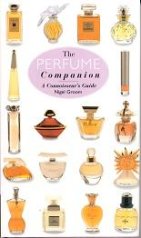 The smallest coffee-table book in my collection is Nigel Groom's Perfume Companion. It has the shape and size of a travel guide, which makes it a handy companion indeed: you can bring it along to the dentist, the hair salon, the nail studio, or the gym. But let's assume you have no intention to do that. What other advantages does a compact guide like The Perfume Companion have over ordinary coffee-table books? To answer that question, let's see what this "Connoisseur's Guide" has to offer.
The smallest coffee-table book in my collection is Nigel Groom's Perfume Companion. It has the shape and size of a travel guide, which makes it a handy companion indeed: you can bring it along to the dentist, the hair salon, the nail studio, or the gym. But let's assume you have no intention to do that. What other advantages does a compact guide like The Perfume Companion have over ordinary coffee-table books? To answer that question, let's see what this "Connoisseur's Guide" has to offer.
The Perfume Companion consists of two parts. Part one is essentially a quick guide to perfumery, featuring a brief historical overview of the industry (so brief it doesn't mention Chanel in the paragraph on fashion and fragrance), and the usual information on ingredients and manufacturing processes. There's also an interesting (albeit largely outdated) section on today's leading perfumers and bottle designers, and a primer on how to choose and use perfume. The advice given is very generic, and clearly intended for novice perfume enthusiasts. An example:
Always try a fragrance on your own skin, but preferably not if you have just been eating strongly flavored food, or vigorously exercising, or if you have not quite recovered from an illness, feel out of sorts, or just have been smoking. (p.36)
The true "connoisseur" will skip this section and go straight to part two of the book: the perfume directory. From Amouage to Worth, the directory covers nearly one hundred perfume brands, offering a concise description of their fragrances and a brief company history. Even relatively small businesses like Jo Malone and Nicole Miller are listed, as well as some rather obscure brands (Perfumes Isabell, Royal Doulton, and Joseph). Unfortunately, a number of trusted names are dearly missed: while there's an entire page dedicated to L'Artisan Parfumeur, brands like Maître Parfumeur et Gantier, Lorenzo Villoresi, or even Comme des Garçons are missing.
The Perfume Companion (first published in 1999) is now little more than an antiquated guide. The industry has changed considerably in the past seven years: just think of Frédéric Malle's Éditions de Parfums, or Bond No.9. But the main problem is that this "Connoisseur's Guide" doesn't live up to its title: apart from the modest price, I don't see any added value in this travel-sized coffee-table book (unless you have a really tiny coffee-table).
New and used copies of this title can be found online at around $15. If I'm not mistaken, it was published in the United States as Perfume: The Ultimate Guide to the World's Finest Fragrances (1999).
Nigel Groom is a perfume consultant who lived in South Arabia for many years. He wrote Frankincense and Myrrh (1981), The Perfume Handbook (1992), and The New Perfume Handbook (1997).
The Perfume Companion: A Connoisseur's Guide
Nigel Groom
London: The Apple Press (1999)
Hardcover, 192 pages
Note: Marcello is on vacation and will not be able to respond to comments.
Leave a reply
You must be logged in to post a comment.